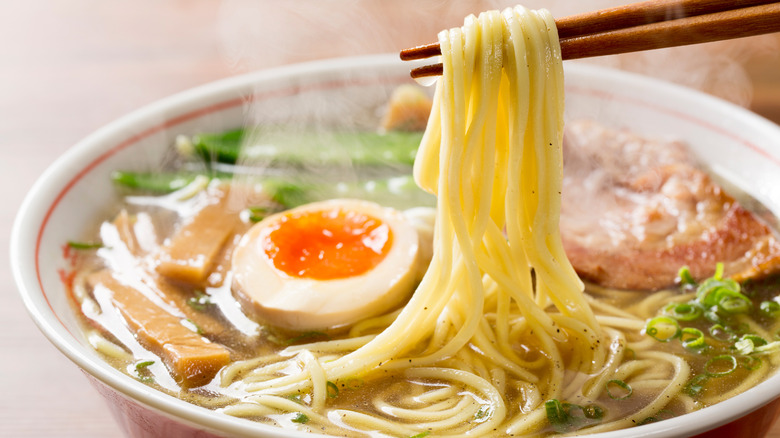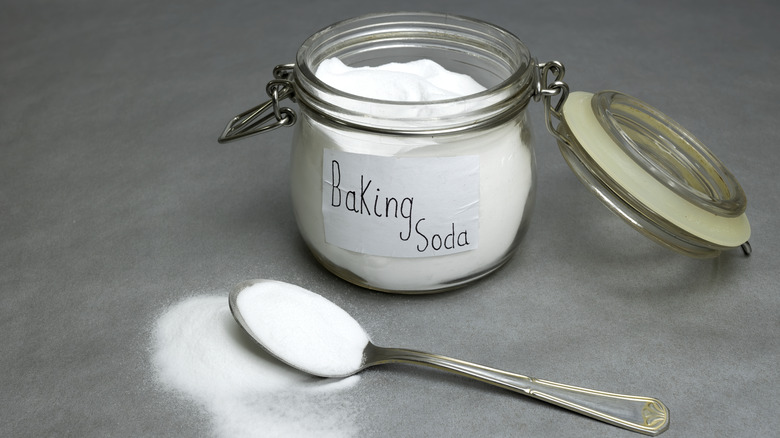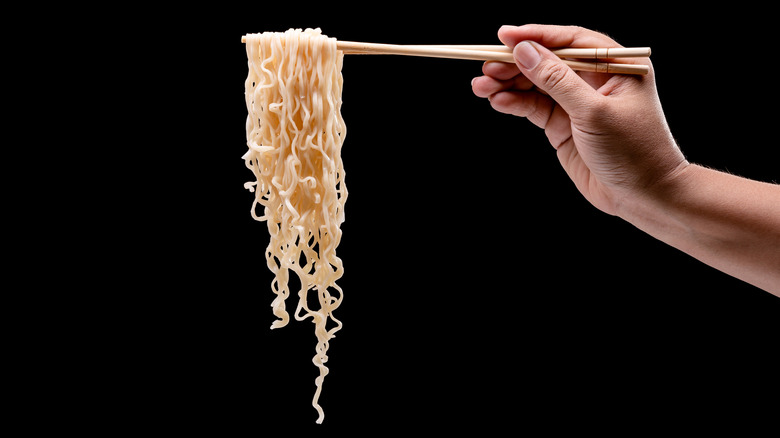The Make-Or-Break Ingredient You Need For Sturdy Ramen Noodles
A bowl of ramen is only as good as its noodles. Ramen noodles should be soft, springy, and chewy; they should be firm but not quite as al dente as the texture associated with pasta. Achieving this soft but sturdy texture is easier said than done because ramen noodles need to have enough teeth to hold up to the weight of the broth that they come swimming in. All this depends on one main ingredient: kansui. But without any on hand, baked baking soda — also known as washing soda or soda — is an easy substitute.
Kansui is an alkaline mineral water solution that contains potassium carbonate and sodium carbonate along with phosphate salts — all things that give the noodles their springy elasticity and sturdy chew. Unfortunately, kansui can be hard to find in everyday grocery stores, and it's more hassle than it's worth to track the alkaline solution down for a batch of homemade noodles. Baking soda, however, is widely available.
Baking soda and baked baking soda are two different things
Baked baking soda also goes by sodium carbonate, which is not to be confused with sodium bicarbonate, or baking soda. Both baking soda and baked baking soda are classified as alkalis, which are chemical compounds that give several foods their distinct flavors, textures, and aromas. Baking soda is predominantly used in bakes where the soda reacts with acids like vinegar to produce carbon dioxide, causing the flour and sugar to rise into fluffy and airy sponges.
By baking the soda, however, you make a more powerful version of the leavener. To get into the science of things, Harold McGee explains in a New York Times article that carbonates like baking soda make for pretty weak alkalis because they only have protons and no hydroxyls. This matters because hydroxyls are responsible for the slick and slippery texture that alkalis add to foods like ramen noodles.
On its own, baking soda only has protons, and so it's too feeble to be used for anything beyond its leavening properties. By baking it in an oven, you rid the soda of its water, carbon dioxide, and protons to create what McGee calls a "more muscular and versatile alkali" that can bring the punchiness, flavors, and textures that lye — a strong alkali that's often used in cleaning solutions — does to food but which happens to be much safer. In the end, you have an alkali that's somewhere between baking soda and lye in strength.
What does this mean for your ramen noodles?
Protons, hydroxyls, and alkalis are great, but what does that have to do with ramen noodles? Well, the texture of ramen noodles is hard to achieve with just flour and water. It depends very much on kansui, and in the absence of this alkaline solution, baked baking soda rises to the occasion.
Baked soda will tighten the gluten present in the dough to give the wheat noodles a stretchy resistance and a springy texture that is tender on the tongue but still has some bounce and sloppiness — while also giving the noodles a yellowish hue. In fact, Harold McGee even tested the kansui substitute in a recipe published by David Chang in his cookbook "Momofuku." The author found that baked soda worked tremendously well on its own to give ramen noodles their distinct texture without any kansui.
To make baked soda, you simply need to spread some baking soda in a tray and pop it in the oven at 250 to 300 degrees F for 1 hour. There may be no noticeable difference after, but the baked baking soda will have lost at least a third of its weight from the loss of water and carbon dioxide. Once baked, use 2 teaspoons of baked baking soda for every 4 cups of flour. The only thing to be careful of is to not get the sodium carbonate on your skin as it's more caustic than baking soda and can cause some irritation.



